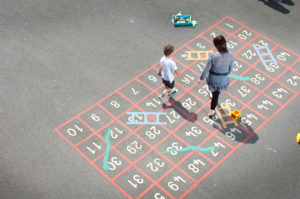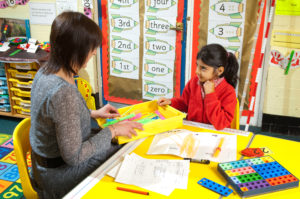Appoint a Numbers Count Teacher
You will need to appoint a Numbers Count teacher who:
- has Qualified Teacher Status and has passed any relevant statutory induction period
- has the equivalent of at least two years of recent, relevant, successful teaching experience.
Some schools choose to deploy an existing member of staff, who may be a class teacher and/or a member of the senior management team, to combine part-time Numbers Count teaching with part-time continuation of their previous role.
Other schools choose to recruit a new member of staff. You might recruit a new Numbers Count teacher who will receive full training in his/her first year, or you might recruit a teacher who has already been trained and accredited elsewhere.
If there are ECC schools local to you, then wherever possible, a newly recruited or potential Numbers Count teacher should visit one and observe a Numbers Count lesson in the term before s/he begins to teach Numbers Count. This will help him/her to understand the nature of their new role and to hit the ground running when s/he starts.
Identify a Numbers Count Link Teacher
The school should choose an experienced member of the senior leadership team to be the Numbers Count Link Teacher. The Link Teacher will help to promote and sustain Numbers Count within the school, will support the Numbers Count Teacher and will carry out exit assessments of learners’ progress after training from the ECC Trainer.
Identify and Prepare a Teaching Area
The school can identify and begin to prepare a Numbers Count teaching area. It should:
- be well lit and ventilated and at a comfortable temperature
- have appropriate furniture with a suitable chair for the teacher
- have appropriate resources to enable the creation of a number-rich environment
- have suitable storage to enable easy access to and use of the resources
- enable learners to move around during the lesson
- enable active and sometimes noisy Numbers Count lessons to be conducted without disturbing or being disturbed by the work of the school.
How Can We Manage Numbers Count?
The minimum requirement for a Numbers Count teacher to become accredited is that s/he teaches 6 learners 1-to-1 while being trained; each child should receive at least 3 and preferably 5 lessons a week, with a total of at least 40 lessons. S/he can maintain accreditation by teaching at least 3 learners per year, teaching them individually or teaching 2 or 3 learners together.
A Numbers Count teacher normally works on a 0.5 or 0.6 timetable, but schools also adopt many other models. The following examples illustrate schools different approaches.
SCHOOL A has a new teacher in training who has a 0.5 timetable and gives Numbers Count support to 14 learners in his/her first year.
- While being trained, s/he teaches 4 learners 1-1 for 5 mornings a week in each of the autumn and spring terms.
- When s/he has been accredited, s/he teaches 6 learners in flexible group sizes for 5 mornings a week in the summer term.
SCHOOL B has a new teacher in training who has a 0.3 timetable and gives Numbers Count support to 8 learners in his/her first year.
- S/he teaches 4 learners 1-1 for 3 mornings a week in the first half of the year, and another 4 learners in the second half.
- S/he is accredited at the end of the year and will be able to teach learners in flexible group sizes in the next year.
SCHOOL C has an accredited teacher who has a 0.6 timetable and gives Numbers Count support to 20 learners in the year.
- S/he teaches Numbers Count for five half days per week. In the autumn term, she gives 1-1 lessons to 4 learners who have the greatest difficulty with mathematics. In each of the spring and summer terms, s/he gives mainly 1-2 lessons to 8 learners who have slightly less difficulty with mathematics.
- S/he spends half a day per week supporting teaching assistants to deliver lighter touch interventions in Key Stage 2 and helping class teachers across the school to implement suitable practice adapted from Numbers Count.
SCHOOL D has an accredited teacher with a 0.4 timetable who gives Numbers Count support to 12 learners in the year.
- S/he teaches Numbers Count three afternoons per week to 6 learners in the first half of the year and another 6 in the second half, in flexible group sizes.
- S/he spends one afternoon per week in the autumn term with selected learners in Key Stage 2 who have previously graduated from Numbers Count, giving them a combination of 1-1 lessons and in-class support.
- S/he spends one afternoon per week in the spring and summer terms helping class teachers across the school to implement suitable practice adapted from Numbers Count.
SCHOOL E is the leading Numbers Count school in a cluster of 6 schools. It employs a full-time accredited teacher who gives Numbers Count support to up to 48 learners across the cluster in the year. The cluster shares the cost of the teacher.
- S/he teaches Numbers Count four mornings per week in one school and four afternoons per week in another every term, supporting 4-8 learners in group sizes agreed with each school.
- S/he spends one day per week supporting teaching assistants across all schools who deliver lighter touch interventions in Key Stages 1 and 2.
- She helps teachers to raise mathematics standards across all schools through a combination of 1-1 support, whole-school support for individual schools, and cluster-wide INSET, e.g. for all Year 2 teachers.







